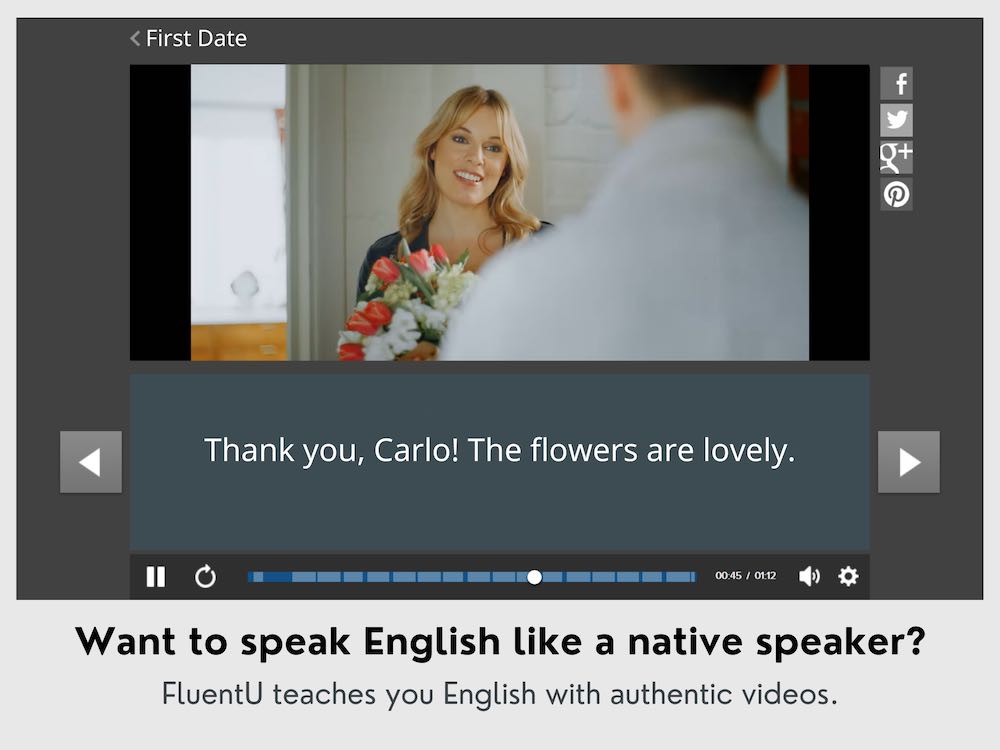
To vs. For: What’s the Difference?
Look at these two sentences:
Can you bring some flowers for Mary?
Can you bring some flowers to Mary?
These sentences have different meanings. But maybe you can’t see why.
Some pairs of similar English words like “to” and “for” can be difficult for English learners.
In this post, I’ll explain the main differences between “to” and “for.”
Ready for it? Let’s go!
Contents
Download: This blog post is available as a convenient and portable PDF that you can take anywhere. Click here to get a copy. (Download)
How to Use “To” and “For” in English Sentences
“To” and “for” are commonly used as prepositions. Changing a preposition, such as using “to” in the place of “for,” can completely alter the meaning of a sentence.
Sometimes, if you use the wrong word, you’ll get a sentence that isn’t grammatically correct.
So, let’s begin by talking about one of the most common (and most confusing) uses of “to” and “for”:
Using “To” vs. “For” to Talk About Reasons and Purposes
We frequently use the prepositions “to” and “for” to talk about why somebody did something. Let’s look at a few examples.
Why did you travel to London?
I traveled to London to improve my English.
Why did she buy a cake?
She bought a cake for her brother’s birthday.
Why are you going home?
I’m going home to feed my cats.
Why did you go to the museum yesterday?
I went to the museum for a lecture on modern art.
In sentences like these, “to” and “for” mean the same thing, but they aren’t used in the same way.
For example, if you said, “I’m going home for feed my cats,” that would be incorrect. You need to use “to.”
So, how do you know when to use “to” and when to use “for”?
It might seem complicated, but the answer is actually very simple. Use “to” when the reason or purpose is a verb. Use “for” when the reason or purpose is a noun.
That’s all!
Let’s look at some more examples of “to” and “for” used side-by-side:
I bought a present to give to Sarah on her birthday. (verb)
I bought a present for Sarah’s birthday. (noun)
I drink coffee to feel more awake. (verb)
I drink coffee for its wonderful taste. (noun)
I’m exercising to stay healthy. (verb)
I’m exercising for my health. (noun)
Once you’ve learned that rule, using “to” and “for” becomes much easier. Now that you’ve mastered the hardest part, let’s look at some other uses of “to” and “for.”
Other Uses of the Word “To”
Here are some of the situations where we commonly use “to.”
Use “to” when talking about movement or a change in direction
“To” is used as a preposition if there’s movement, a transfer or a change in direction from one point to another.
For example,
I need you to take these books to Mary.
We are going to Paris next Tuesday.
In the first example, “to” is used to suggest a transfer of the books from “you” to “Mary.” In the next example, “to” indicates (shows) a change of place from the speaker’s location to Paris.
Use “to” with English infinitive verbs
Any English verb in the infinitive form will include the word “to.” You will frequently see this construction in English sentences.
For example,
Nina loves to talk on the phone.
When do you want to eat dinner?
We’re going to meet the Queen tomorrow!
Use “to” when comparing two things
“To” is often used in comparing two things and expressing one’s preferences (likes).
For example,
I prefer coffee to tea.
She prefers reading books to watching movies.
Other Uses of the Word “For”
Now it’s time to learn about the word “for.” “For” is used as both a preposition and conjunction, but it’s much more common as a preposition.
Let’s learn when to use it!
Use “for” when expressing thanks or gratitude
If you want to thank someone, you’ll usually use the word “for” to explain why you’re thanking them.
The word “for” will be followed by a noun or gerund (a verb that ends with “-ing”).
For example,
Thank you for teaching me to play the guitar.
Thanks so much for the new shoes!
Matthew thanked Brian for coming to his birthday party.
Use “for” when talking about a duration of time
“For” is also used to talk about a length of time during which something happened.
For example,
I waited at the station for two hours.
They have lived in Ohio for eight years.
We’ve known each other for a long time.
Use “for” when expressing support and agreement
“For” is used to indicate agreement with or support of a cause.
For example,
Are you for or against the women’s movement?
I’m all for increasing taxes.
To vs. For: Test Your Understanding with a Simple Quiz
Now it’s time for a short quiz to test your understanding of when to use “for” and “to.” Fill in the blanks with the right word and check with the answers that are given at the end of it.
- Jeet went ____ New York ____ see his favorite rock band perform live.
- I need to give my essay ____ the professor before 5:00.
- He lived in Paris ____ three years.
- I’m looking ____ a new job.
- Are you ____ or against the environmentalist movement?
- Thank you so much ____ your kind letter.
- I prefer Rohan ____ Ben.
- I want ____ eat pizza for dinner.
- His parents sacrificed so much ____ him.
- Will you please take these books ____ the library ____ me?
(Answers: 1. to/to, 2. to, 3. for 4. for, 5. for, 6. for, 7. to, 8. to, 9. for, 10. to/for)
More Resources for Practicing Using “To” and “For”
Learning grammar rules isn’t enough. To properly learn the differences between “to” and “for,” you need to practice. Below are some of the best resources.
Online quizzes and exercises are a quick and efficient way to learn English words. They help you check your English learning progress.
UsingEnglish has a short quiz of 10 questions for beginners, which also comes with a printable worksheet.
Autoenglish.org offers a slightly more difficult exercise. If you do well in it, you’ll never be confused between “to” and “for.”
Finally, both English Super Site and To Learn English have 15-question quizzes that cover a variety of situations where “for” and “to” are commonly used.
Another important way to get to know “to” and “for” is to hear them in use, like in movies and commercials.
FluentU takes authentic videos—like music videos, movie trailers, news and inspiring talks—and turns them into personalized language learning lessons.
You can try FluentU for free for 2 weeks. Check out the website or download the iOS app or Android app.
P.S. Click here to take advantage of our current sale! (Expires at the end of this month.)

I hope the differences between “to” and “for” are clear to you now.
If you make mistakes, that’s completely okay. I made a lot of grammar mistakes when I first started out, and hey—even native speakers misuse common English words sometimes.
Mistakes are fine, as long as you learn from them. Just keep studying. Come up with your own examples and use the words in your daily conversations. Over time, practice will increase your confidence. Soon enough, you’ll become a fluent English speaker!
Download: This blog post is available as a convenient and portable PDF that you can take anywhere. Click here to get a copy. (Download)
And One More Thing...
If you like learning English through movies and online media, you should also check out FluentU. FluentU lets you learn English from popular talk shows, catchy music videos and funny commercials, as you can see here:
The FluentU app and website makes it really easy to watch English videos. There are captions that are interactive. That means you can tap on any word to see an image, definition, and useful examples.
For example, when you tap on the word "searching," you see this:
Learn all the vocabulary in any video with quizzes. Swipe left or right to see more examples for the word you’re learning.

FluentU helps you learn fast with useful questions and multiple examples. Learn more.
The best part? FluentU remembers the vocabulary that you’re learning. It gives you extra practice with difficult words—and reminds you when it’s time to review what you’ve learned. You have a truly personalized experience.
Start using the FluentU website on your computer or tablet or, better yet, download the FluentU app from the iTunes or Google Play store. Click here to take advantage of our current sale! (Expires at the end of this month.)











